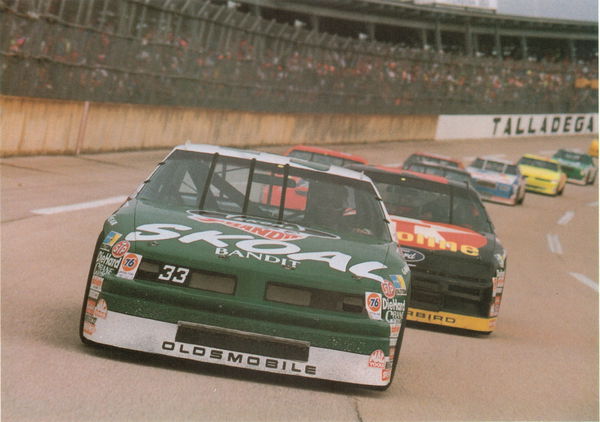

From colorful expletives to race-morphing strategies, the radio is a wondrous tool in NASCAR. In all three of NASCAR’s top series, race teams invest thousands of dollars in their communication system. It is a crucial part of their run and often determines the ultimate winner. So can you imagine tuning into that radio and listening to those valuable conversations? Seems unimaginable, right?
Well, fans can do that, but only after paying a sizeable amount of money. However, can you believe that there was a time when you could tune into your favorite driver’s radio for free? Just dial the right number and bingo, you are listening to live race interactions. Although there were privacy issues, fans longingly look back at that thrilling time.
When you could hear live NASCAR
ADVERTISEMENT
Article continues below this ad
A lot of things unfold on a team’s radio when things are intense in a race. Sometimes, drivers land themselves in serious trouble like Kyle Larson did in 2020. The racial slur that slipped out of his mouth during a race practice was public and led to a hefty punishment. Then drivers’ true emotions are betrayed. For instance, the Coke Zero Sugar 400 race witnessed some scary wrecks. Josh Berry’s mishap elicited concerned reactions from many racers and crew chiefs, with Martin Truex Jr bashing NASCAR.
But unlike the limited number of fans who can actually tune into this chatter, once there were no boundaries. At the cusp of the 21st century, fans could dial in their favorite team frequency and listen to their entire radio communication throughout the race weekend. Radio chatter can range from crew chiefs enlightening drivers about car performance or pit stops to drivers loudly snoring during a red flag. Overall, it is an entertaining experience that is crucial to the fans. A recently dug-out 2001 Coke commercial demonstrated this old privilege.
In 2001, you could call a phone number and listen to team radios by phone pic.twitter.com/xyR6XItDqB
— nascarman (@nascarman_rr) September 3, 2024
What’s your perspective on:
Do you miss the raw, unfiltered racing of old NASCAR, or do you prefer today's tech-driven approach?
Have an interesting take?
Yet, once in 2009, a heated exchange between Kurt Busch and Roger Penske went viral. That led Busch to question NASCAR’s system of allowing public ears into the radio. He compared the situation with other sports. “I’ve always thought that the radio should be utilized as a team tool. We don’t get to hear what a coach says to his offensive and defensive coordinators in the NFL. You don’t get to hear in baseball when they call to the bullpen. You don’t get to hear what they say in the huddle during a football game, and what they say in the huddle is usually animated.”
Maybe that laid the basis for NASCAR eventually restricting access to teams’ radio chatter. Yet, current fans are bathing in the nostalgia of that time.
NASCAR fans long for free audio
ADVERTISEMENT
Article continues below this ad
Trending
Ryan Blaney Risking Upsetting His Soon to Be Wife as He Reveals His Plans for the Off-Season After Failing to Defend His Title

New Parents Tony Stewart and Leah Pruett Share Their Complete Family Photo, and Fans Pour in Love for Baby Stewart

Who Is Chase Elliott’s Girlfriend Ashley Anderson? Everything You Need to Know About NASCAR’s Most Popular Driver’s Rumored Love Interest

Dale Earnhardt Jr.’s Wife “Fell Asleep,” Missing Her Husband’s Historic Bud Return to the Track

Martin Truex Jr. Girlfriend: Who Is Emily Collins, the Former JGR Star’s Red Carpet Flame

Currently, NASCAR entertains only a select audience for the race radio. The two-way radios are specially programmed with codes to allow only authorized personnel to listen on a given frequency. If fans want to tune into the chatter, they need to subscribe to the NASCAR app and buy their way in. That is what a contemporary fan lamented about: “i love the fact that you could do this for free before i was born, yet nowadays you can literally do the same thing but with a paid subscription to the nascar app instead 😭” Another fan struck a sentimental chord as they noted the drastic and painful advancement of the sport. “This is what they took from us.”
Indeed, before the future set in, things may have been way more exciting, as some fans implied. In the pre-internet age, one fan demonstrated the unbelievable freedom that they had to enjoy NASCAR races. “Like 20 years ago directv let you select like 1 of 20 different scanners to play over the broadcast. No internet required. Then they also had them hot pass channels which were pretty sweet.”
Another fan related with the Coke commercial fellow and said they also engaged in a similar activity. “I feel old. Are you going to also tell me other people didn’t connect the Mountain Dew bottle caps of every team name in hopes they win the NCAA Tournament?”
ADVERTISEMENT
Article continues below this ad
The Coke commercial was filmed in a crucial year, one that changed the course of NASCAR forever. Dale Earnhardt, famously called The Intimidator, passed away at the Daytona 500 in 2001. So one fan commented that they listened to the legendary driver’s last few moments of radio chatter before his last breath. “I did that for the 01 500. You got to listen for 15 minutes. Listened to dale for the last 5 laps.” Well, that was a precious privilege indeed.
Evidently, gearheads dearly miss the time when NASCAR kept things easily accessible. However, issues like privacy and commercialization ultimately changed the sport.
Have something to say?
Let the world know your perspective.


Debate
Do you miss the raw, unfiltered racing of old NASCAR, or do you prefer today's tech-driven approach?